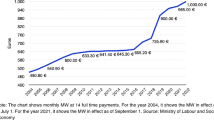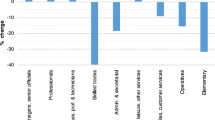Abstract
This paper uses Italian panel data to analyse low pay transitions since the early 1990s. Results indicate that having more human capital reduces the probability of falling into low pay, but there is little impact on raising exit rates from low pay. Human capital effects are found to be larger for women than for men. There is considerable state dependence: the experience of low pay raises the probability of subsequent low pay episodes. Also, there is substantial unobserved heterogeneity associated with factors such as initial conditions, mobility out of the earnings distribution and educational attainment.
Similar content being viewed by others
Notes
Estimates of income mobility have recently proven useful for evaluating the need for redistribution through taxation (Alesina and La Ferrara (2005).
See Heckman (1981a) for a seminal contribution on state dependence in dynamic econometric models of labour market outcomes.
I am discussing regression-type models for earnings transition probabilities. Alternative approaches in the mobility literature are those based on lifetime inequality indices or stochastic processes for individual earnings profiles (see, e.g. Buchinsky and Hunt 1999 and Moffitt and Gottschalk 1995 for applications).
Similar conclusions were reached by Cappellari (2002) who applied that model to Italian data for the early 1990s.
See D’Alessio and Faiella (2000) for a general description of the survey.
Given the Italian family-based system of taxation, net earnings not only reflect productivity and the features of the labour market but also family circumstances, so that in the analysis it will be important to account for household structure.
I also analysed monthly earnings and found results to be similar to those obtained on hourly earnings. Results obtained using monthly earnings are available upon request.
To assess the robustness of results to the choice of the low pay cut-off, I estimated the model using alternatively a lower and a higher threshold, namely, two-thirds of the median and the third decile. Findings from these supplementary analyses indicate that the results of the paper are not sensitive to the choice of the low pay threshold, and are available upon request.
See Wooldridge (2005) for an alternative approach.
Such an approach, based on the pooling of observations across transitions, is equivalent to the one of the pooled probit estimator discussed, e.g. by Woolridge (2002, chapter 13).
Before 1969, students from technical secondary schools who wanted to enrol into college had to go through a special examination. The reform abolished the exam, equalizing enrolment requirements of technical and general schools students (see Brunello and Miniaci 1999 for a discussion).
Individuals in the sample completed their educational investments before a set of reforms of secondary and tertiary education was put in place in the late 1990s/early 2000s, somehow modifying the classification of degrees and the mapping between degrees obtained and years of education. The SHIW variable also records (but only from 1995 onwards) whether individuals have a vocational qualification that can be obtained with two or three years of vocational training after lower secondary schools, whether they obtained a short (2 years) college diploma, and postgraduate qualifications.
The indicator function I(A) takes value 1 whenever its argument is true and 0 otherwise.
One might also think of \(l^{ * }_{{it - 2}} \) as a monotonic unspecified transformation of individual earnings, such as the normality assumption holds (Stewart and Swaffield 1999).
Firm size in the SHIW is recorded in classes, and the threshold that triggers variations in the intensity of employment protection legislation (i.e. 15 employees) falls within one of such classes (5 to 19).
Including the square of experience in the transition equation did not produce statistically significant estimates of the associated coefficient.
Four-dimensional normal integrals required for estimation are evaluated via simulation using the GHK simulator. Likelihood contributions are provided in the Appendix.
Similar results were obtained by following the testing strategy of Stewart and Swaffield (1999), who considered the restriction on squared labour market experience as the identifying one.
References
Alesina A, La Ferrara E (2005) Preferences for redistribution in the land of opportunities. J Public Econ 89(5–6):897–931
Arulampalam W, Booth AL, Taylor MP (2000) Unemployment persistence. Oxf Econ Pap 52(1):24–50
Atkinson AB, Bourguignon F, Morrisson C (1992) Empirical studies of earnings mobility, Harwood Academic, Switzerland
Bingley P, Bjørn J, Westergård-Nielsen N (1995) Determinants of wage mobility in Denmark 1980–1990. Centre for Labour Market Studies, working paper no. 10–95. University of Aarhus, Aarhus
Brandolini A, Cipollone P, Sestito P (2002) Earnings dispersion, low pay and household poverty in Italy, 1977–1998. In: Cohen D, Piketty T, Saint-Paul G (eds) The economics of rising inequalities. Oxford Univ. Press, Oxford, New York, pp 225–264
Brunello G, Miniaci R (1999) The economic returns to schooling for Italian men. An evaluation based on instrumental variables. Labour Econ 6(4):509–519
Buchinsky M, Hunt J (1999) Wage mobility in the United States. Rev Econ Stat 81(3):351–368
Cappellari L (2002) Do the ‘working poor’ stay poor? An analysis of low pay transitions in Italy. Oxf Bull Econ Stat 64(2):87–110
Cappellari L, Jenkins SP (2004) Modelling low income transitions. J Appl Econ 19(5):593–610
Card D (1999) The causal effect of education on earnings. In: Ashenfelter O, Card D (eds) Handbook of labor economics, vol 3A. North-Holland, Amsterdam pp 1063–1801
D’Alessio G, Faiella I (2000) I Bilanci delle Famiglie Italiane nell’Anno 1998. Supplementi al Bollettino Statistico 22. Banca d’Italia, Roma
Erickson C, Ichino A (1995) Wage differentials in Italy: market forces, institutions and inflation. In: Freeman R, Katz L (eds) Differences and changes in the wage structure. Chicago Univ. Press, Chicago, pp 265–305
European Commission (2004) Labour market transitions and advancement: temporary employment and low pay. In: Employment in Europe: recent trends and prospects. Luxembourg, pp 159–186
Gregory M, Elias P (1994) Earnings transitions of the low paid in Britain, 1976–91: a longitudinal study. Int J Manpow 15(2/3):170–188
Heckman JJ (1981a) Heterogeneity and state dependence. In: Rosen S (ed) Studies in labour markets. Chicago Univ. Press, Chicago, pp 91–139
Heckman JJ (1981b) The incidental parameters problem and the problem of initial conditions in estimating a discrete time–discrete data stochastic process. In: Manski CF, McFadden D (eds) Structural analysis of discrete data with economic applications. MIT Press, Cambridge, MA, pp 114–178
Jenkins SP (2000) Modelling household income dynamics. J Popul Econ 13(4):529–567
Moffitt R, Gottschalk P (1995) Trends in the covariance structure of earnings in the US: 1969–1987. Working Papers in Economics no. 355. The John Hopkins Univ. Press, Baltimore
OECD (1997) Employment outlook. OECD, Paris
OECD (2002) Education at a glance. OECD, Paris
Smith RE, Vavrichek B (1992) The wage mobility of minimum wage workers. Ind Labor Relat Rev 46(1):82–88
Stewart MB (2004) The inter-related dynamics of unemployment and low pay. Department of Economics, University of Warwick (in press)
Stewart MB, Swaffield JK (1999) Low pay dynamics and transition probabilities. Economica 66(261):23–42
Wooldridge J (2002) Econometric analysis of cross-sectional and panel data. MIT Press, Cambridge, MA
Wooldridge J (2005) Simple solutions to the initial conditions problem for dynamic, non-linear panel data models with unobserved heterogeneity. J Appl Econ 20(1):39–54
Zabel JE (1998) An analysis of attrition in the panel study of income dynamics and the survey of income and program participation. J Hum Resour 33(2):479–506
Acknowledgements
Thanks are due to Wiji Arulampalam, Carlo Dell’Aringa, Stephen Jenkins, Claudio Lucifora, Mark Stewart, the editor Christian Dustmann and two anonymous referees for very helpful comments. Financial support from the Nuffield Foundation (New Career Development Scheme) is gratefully acknowledged. Usual disclaimers apply.
Author information
Authors and Affiliations
Corresponding author
Additional information
Responsible editor: Christian Dustmann
Appendix
Appendix
The model of Section 3 is a four-variate probit with endogenous truncation and endogenous switching. The four equations, given in the text, are:
The low pay transition equation is truncated for observations that leave the sample between t−2 and t (i.e. when R it =0) and allows switching of the parameter vector of interest according to initial conditions.
Errors are assumed to be jointly distributed as four-variate normal with zero mean, unit variances and free correlation coefficients: \({\left( {u_{{it - 2}} \varepsilon _{{it}} ,\xi _{i} ,v_{{it}} ,} \right)} \sim N_{4} {\left( {0,\Omega } \right)}.{\left( {i = {\text{l}} \ldots n} \right)}\)
Likelihood contributions take the following form:
where \(\Phi _{j} \) denotes the j-variate normal\({\text{c}}{\text{.d}}{\text{.f}}{\text{., }}L_{i} \Xi _{{{\left( k \right)}i}} ,\;k = 1,2, \) the vector of index functions for individual i, whose low pay transition component switches according to initial conditions, and the _Lt subscript denotes vectors and matrices deprived of elements referring to the low pay transitions equation.
Computation of multivariate normal distributions is performed by applying the Geweke–Hajivassiliou–Keane (GHK) simulator, yielding a maximum simulated likelihood (MSL) estimator.
Table 4 presents results in terms of marginal effects on estimated low pay persistence (p it ) and entry (e it ) probabilities, computed as:
where a _S subscript denotes vectors and matrices deprived of elements referring to the education equation. (Because these probabilities are not truncated upon education, the individual specific educational effect \(\xi _{i}\) i integrates out, so that their evaluation only requires trivariate and bivariate normal integrals.) The effect considered is the one induced on transition probabilities by changes in the elements of z it−2 relative to the reference person described in the text. Note that such changes will, in general, also affect the conditioning events, therefore complicating the interpretation of the effects estimated. To circumvent those complications, I fixed the probabilities of conditioning events at their sample averages, using the arguments of those average probabilities into the transition rates given in Eq. 12.
Rights and permissions
About this article
Cite this article
Cappellari, L. Earnings mobility among Italian low-paid workers. J Popul Econ 20, 465–482 (2007). https://doi.org/10.1007/s00148-006-0065-z
Received:
Accepted:
Published:
Issue Date:
DOI: https://doi.org/10.1007/s00148-006-0065-z




